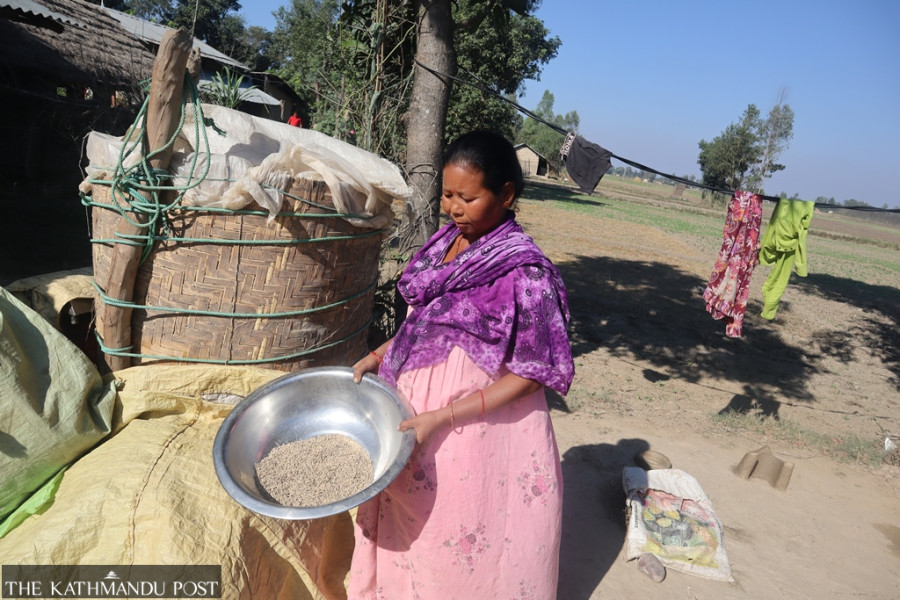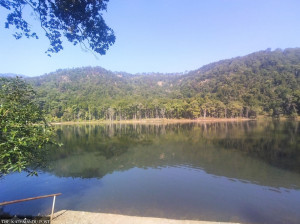Sudurpaschim Province
Paddy production hit after flooding becomes more frequent in Bhajani
Nearly 20,000 families were affected by the floods and inundation in several districts in September. The floods inundated houses and paddy fields belonging to around 9,000 families in Bhajani alone.
Mohan Budhaair
Santoli Dagaura Tharu, a local farmer of Pakadiya in Bhajani Municipality-3, is facing a shortage of food this year. She owns 11 kattha (0.9 acre] of farmland which would produce more than enough for her four-member family.
“I used to sell the surplus paddy and maize and manage other family expenses with that income. But this year the produce was not enough even for the family. The floods in September destroyed the ready-to-harvest paddy,” said Santoli. According to her, she used to harvest 24 quintals of paddy, but this season she could collect merely four quintals of rice. “Even the paddy harvested this season is not of good quality. The floods damaged the crops. The paddy is black and nobody wants to buy it.”
Santoli’s family had lived on the Postal Highway, which is higher than the surrounding fields, for about two weeks after the floods inundated her house in September second week. “We were without food for three days. The floods destroyed all the food grains and clothes. The local unit and various organisations provided us food during our stay on the roadside. But we had to deal with a shortage of food after we returned home. We are now buying food grains this year by taking a loan,” said Santoli.
Her harvest last year also was not as good as expected because of excess rainfall, she says.
Bhajani lies in the lower plains in Kailali, a Tarai district of the Sudurpaschim Province, and is famous for its paddy production. Several local bodies in the southern part of the district including Bhajani, Tikapur, Kailari and Joshipur are often affected by floods every year. According to the District Administration Office, nearly 20,000 families were affected by the floods and inundation in the area in September. The September floods inundated houses and paddy fields belonging to around 9,000 families in Bhajani alone.

“The Bhajani area has been prone to floods even in the months of September and October for the past few years. The unseasonal floods in September and October damaged paddy this year. The local people are under a food crisis now,” said Ramdev Dagaura, another local of Pakadiya. According to him, the paddy produced in his seven kattha of land used to be enough for his family for a year. “But we have been buying rice for household consumption for the past three years after floods started destroying the crops,” he said.
Bhajani is mostly populated by Tharu people. “Rice is the main staple food for the Tharu community. But of late our diet has shifted to wheat after paddy production slumped,” said Ramdev.
Chhabilal Pokharel, another local of Bhajani, owns a bigha and a half of land. He often earns around Rs100,000 by selling paddy every year. “Our family usually grows around 40 quintals of paddy. This season we hardly harvested 10 quintals of paddy and that too of poor quality,” said Pokharel.
According to Pokharel, around 60 families in Pakadiya settlement have been facing a shortage of food grains since last year. “Many people in the settlement started going to the towns and to India for work in the aftermath of the rice shortage,” he added.
Around 15 percent of annual food production decreased in Kailali due to floods in Bhajani, Tikapur, Kailari and Joshipur, according to Khagendra Sharma, an officer at the Agriculture Knowledge Centre in Kailali.
The Kandra, Pathariya and Mohana rivers flow through Bhajani Municipality. The rivers wreak havoc in the areas whenever it rains in the Chure region. “Most of the rivers and rivulets in Kailali originate from the Chure region. The deforestation in the Chure region and its foothills has exacerbated flooding over the past few years. Even moderate rainfall causes huge damage in Bhajani,” said Bijaya Shrestha, a Kailali-based conservationist.




 8.12°C Kathmandu
8.12°C Kathmandu










%20(1).jpg&w=300&height=200)

